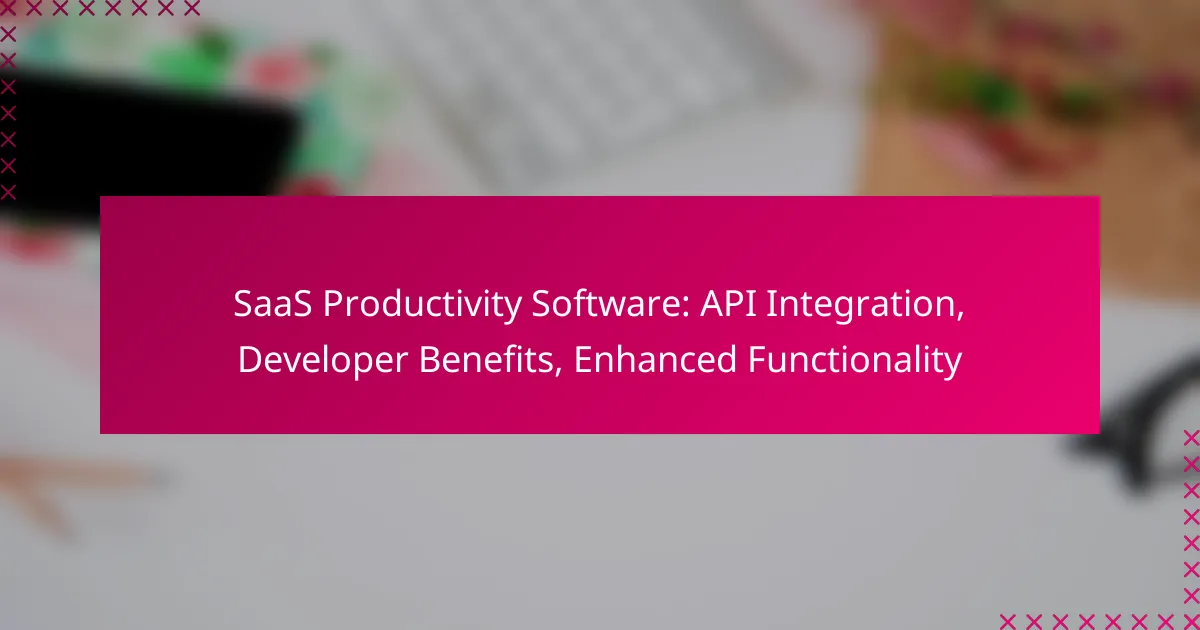SaaS productivity software plays a crucial role in enhancing team collaboration and project management, with popular solutions like Monday.com, Trello, and Asana leading the way. API integration further amplifies these tools by facilitating seamless communication between applications, allowing for automation and customized workflows that boost efficiency. Developers particularly benefit from these enhanced functionalities, as they streamline workflows and improve overall project outcomes.

What are the best SaaS productivity software solutions in Canada?
In Canada, top SaaS productivity software solutions include Monday.com, Trello, Asana, ClickUp, and Notion. These tools enhance team collaboration, streamline project management, and offer various integrations to boost productivity.
Monday.com
Monday.com is a versatile project management tool that allows teams to customize workflows and track progress visually. It offers features like timelines, dashboards, and automation to improve efficiency.
Consider using Monday.com if your team requires a high level of customization and visual project tracking. The pricing ranges from around CAD 10 to CAD 20 per user per month, depending on the features selected.
Trello
Trello utilizes a card-based system to help teams manage tasks and projects easily. Its simplicity makes it ideal for smaller teams or projects that do not require extensive features.
With Trello, you can create boards for different projects and move cards through various stages. The basic version is free, while premium plans start at approximately CAD 12.50 per user per month.
Asana
Asana is designed for task and project management, focusing on team collaboration. It allows users to create tasks, assign them to team members, and set deadlines, making it easier to track progress.
Asana is particularly useful for teams that need to manage multiple projects simultaneously. Pricing starts at around CAD 13.50 per user per month for the premium version, which includes advanced features.
ClickUp
ClickUp is an all-in-one productivity platform that combines task management, document collaboration, and goal tracking. Its flexibility allows teams to tailor the interface to their specific needs.
ClickUp is suitable for teams of all sizes, offering a free version with essential features and paid plans starting at about CAD 5 per user per month. This makes it a cost-effective option for many organizations.
Notion
Notion serves as a workspace that combines notes, tasks, databases, and wikis. It is highly customizable, allowing teams to create a unique setup that fits their workflow.
Notion is ideal for teams looking for a flexible solution that integrates various functions into one platform. The pricing starts at approximately CAD 8 per user per month for the personal pro plan, which unlocks additional features.

How does API integration enhance SaaS productivity software?
API integration significantly enhances SaaS productivity software by enabling seamless communication between different applications. This connectivity allows users to automate processes, synchronize data, and create customized workflows that improve overall efficiency.
Streamlined workflows
API integration streamlines workflows by allowing different software tools to work together without manual intervention. For instance, a project management tool can automatically update task statuses in real-time when changes occur in a connected time-tracking application.
This automation reduces the need for repetitive tasks and minimizes errors, leading to faster project completion. Businesses can implement APIs to create a cohesive ecosystem where each tool complements the others, enhancing productivity.
Data synchronization
Data synchronization through API integration ensures that information remains consistent across various platforms. When a user updates data in one application, APIs can automatically propagate these changes to all connected systems, eliminating discrepancies.
This is particularly useful for businesses that rely on multiple software solutions, as it allows for real-time access to the most current data. For example, syncing customer information between a CRM and an email marketing platform can enhance targeted communication efforts.
Custom automation
Custom automation is a key benefit of API integration, allowing businesses to tailor processes to their specific needs. Organizations can set up triggers and actions that automate tasks based on certain conditions, such as sending notifications when a project milestone is reached.
By leveraging APIs, companies can create unique workflows that align with their operational requirements, reducing manual workload and increasing efficiency. It’s essential to carefully plan these automations to ensure they deliver the desired outcomes without introducing complexity.

What are the developer benefits of using SaaS productivity software?
Developers benefit from SaaS productivity software through enhanced functionality, streamlined workflows, and access to robust integrations. These tools enable efficient application development and collaboration, ultimately improving productivity and project outcomes.
Access to extensive APIs
SaaS productivity software typically offers extensive APIs that allow developers to integrate various functionalities seamlessly. This access enables the automation of tasks, data sharing between applications, and the customization of user experiences. For example, a project management tool may provide APIs to connect with communication platforms, facilitating real-time updates.
When utilizing APIs, developers should consider the documentation quality and support available. Well-documented APIs can significantly reduce integration time and troubleshooting efforts. Additionally, monitoring API usage can help manage costs, as some services may charge based on the number of calls made.
Improved collaboration tools
Many SaaS productivity solutions include built-in collaboration tools that enhance team communication and project management. Features like shared workspaces, real-time editing, and integrated messaging systems allow teams to work together more effectively, regardless of location. For instance, tools like Slack or Microsoft Teams can integrate with project management software to keep all stakeholders informed.
To maximize collaboration, teams should establish clear communication protocols and utilize the available features fully. Regular training on these tools can help ensure that all team members are comfortable using them, which can lead to increased engagement and productivity.
Scalable solutions
SaaS productivity software is designed to scale with the needs of a business, making it suitable for startups and large enterprises alike. As a company grows, these solutions can accommodate increased user numbers and additional features without requiring significant infrastructure changes. This flexibility allows businesses to adapt quickly to market demands.
When selecting a scalable solution, consider factors such as user limits, pricing tiers, and the ability to add functionalities as needed. It’s essential to choose a provider that offers a clear upgrade path, ensuring that your team can grow without facing service interruptions or excessive costs.

What enhanced functionalities do SaaS productivity tools offer?
SaaS productivity tools provide a range of enhanced functionalities that significantly improve collaboration, reporting, and integration capabilities. These features streamline workflows, facilitate real-time communication, and allow for seamless connections with other applications, ultimately boosting overall productivity.
Real-time collaboration
Real-time collaboration enables multiple users to work on the same document or project simultaneously, fostering immediate feedback and interaction. Tools like Google Workspace and Microsoft 365 allow team members to edit, comment, and communicate within the same platform, reducing delays and enhancing teamwork.
To maximize the benefits of real-time collaboration, ensure all team members are trained on the software and establish clear communication protocols. Avoid common pitfalls such as overlapping edits by using version control features or setting specific roles for contributors.
Advanced reporting features
Advanced reporting features in SaaS tools allow users to generate detailed analytics and insights from their data. These functionalities often include customizable dashboards, automated report generation, and data visualization options that help teams make informed decisions quickly.
When utilizing advanced reporting, focus on defining key performance indicators (KPIs) relevant to your goals. Regularly review and adjust your reporting criteria to ensure they align with changing business needs and avoid information overload by filtering out unnecessary data.
Integration with third-party applications
Integration with third-party applications enhances the functionality of SaaS productivity tools by allowing them to connect with other software solutions. This interoperability enables users to streamline processes, share data seamlessly, and reduce manual entry errors.
To effectively leverage integrations, identify the applications that are critical to your workflow and explore available APIs. Use tools like Zapier or Integromat to automate tasks between applications, ensuring that data flows smoothly and efficiently across platforms.

What criteria should be considered when selecting SaaS productivity software?
When selecting SaaS productivity software, focus on integration capabilities, user interface design, and overall functionality. These criteria ensure the software meets your organization’s needs and enhances productivity effectively.
Integration capabilities
Integration capabilities are crucial for ensuring that the SaaS productivity software can seamlessly connect with existing tools and systems. Look for software that supports popular APIs and offers pre-built integrations with other applications your team uses, such as CRM, project management, and communication tools.
Consider the flexibility of the integration options. Some software may provide extensive customization through APIs, allowing developers to tailor the integration to specific workflows. Evaluate whether the software can handle data synchronization and real-time updates, which are essential for maintaining accurate information across platforms.
User interface design
A user-friendly interface is vital for maximizing adoption and productivity. The design should be intuitive, allowing users to navigate easily and access features without extensive training. Look for software that prioritizes usability and provides a clean layout, clear icons, and responsive design.
Additionally, consider the customization options available for the user interface. Some SaaS products allow users to personalize their dashboards and workflows, which can enhance individual productivity. Testing the software with a trial version can help assess whether the user interface meets your team’s needs effectively.
